Physical Address
304 North Cardinal St.
Dorchester Center, MA 02124
Managing femoral bone loss in revision total hip arthroplasty is challenging, requiring meticulous clinical evaluation and preoperative planning.
The ideal revision femoral stem is easy to insert, can be used to treat most revision situations, and has reproducible clinical results.
Extensively porous-coated stems can be used to treat most femoral defects.
Preoperative planning and surgical technique are essential for success with extensively porous-coated stems.
Clinical results show excellent midterm to long-term survival rates in the revision setting.
The success of primary total hip arthroplasty is well documented in the literature, with survival rates greater than 90% at 15-year follow-up. As our population ages, the number of total hip arthroplasties performed is increasing dramatically. Unfortunately, some of these procedures are not successful and require revision. Despite improvements in implant materials and surgical techniques, the number of revisions for failed total hip replacement has not decreased. In addition, expansion of indications to younger, more active patients and improved life expectancy for patients with total hip replacement have increased the number of revisions, and this trend is not expected to decrease. In fact, recent projections indicate that the burden of revision total hip arthroplasty is expected to increase by 137% over the next 25 years. In addition, the cost and resource utilization for revision procedures are substantially higher than those for primary procedures.
The current epidemiology information on failed total hip arthroplasty is gathered mainly from large cohort studies and registry data in Europe, Canada, and Australia. These reports indicate that aseptic loosening, osteolysis/wear, and instability are the major causes of failure for total hip arthroplasty. Sadoghi and colleagues reviewed the data collected in the Scandinavian, Australian, and New Zealand registries over a 30-year period and found that aseptic loosening (55.2%), instability (11.8%), and infection (7.5%) accounted for the majority of revision surgeries.
Springer and associates reviewed a series of 1100 hips that underwent revision total hip arthroplasty over a 20-year period at their institution. The most common reasons for failure of the primary total hip arthroplasty were aseptic loosening and instability. These two diagnoses accounted for 61% of all failed total hip replacements. In addition, instability and aseptic loosening accounted for more than 65% of failures of revision total hip arthroplasty leading to re-revision, indicating an area in which improvement is needed.
Dobzyniak and colleagues evaluated early failures of primary total hip arthroplasty defined as those requiring revision within 5 years of the index arthroplasty. Of 745 revision procedures, 39% occurred within the first 5 years following index total hip arthroplasty. Instability (33%) was the major reason for early failure requiring revision, followed by aseptic loosening (30%) and infection (14%).
Using the Nationwide Inpatient Sample, Bozic and coworkers reviewed 235,857 revision total hip arthroplasties performed in the United States over a 5-year period (October 2005 through December 2010). The purpose of this study was to determine the epidemiology of revision total hip arthroplasty. Revision total hip arthroplasty procedures increased by 23% over the 5-year period. The most common causes of failed total hip arthroplasty requiring revision were instability/dislocation (22%), aseptic loosening (20%), and infection (15%). In addition, full-component revision (femoral and acetabular components) was the most common procedure performed to treat failed arthroplasty (43%).
Managing the revision femur following failed total hip arthroplasty remains technically challenging. Extensive bone loss from aseptic loosening, sepsis, and osteolysis can lead to a variety of bony defects and a multitude of clinical scenarios. The goals of revision total hip arthroplasty are (1) to obtain rigid initial stability of the implants, (2) to engage healthy remaining bone proximally or distally with the implant, and (3) to bypass stress risers.
Implant options for the revision femur are numerous and include cemented and cementless fixation. Cemented fixation allows for immediate fixation, is adaptable to a variety of femoral defects, and allows the use of antibiotic-impregnated cemented materials. In many instances, however, a sclerotic endosteal surface leads to poor cement penetration into bone and a decrease in the strength of the bone-cement interface. Clinical results of cemented femoral stems in revision total hip arthroplasty have been poor, with mechanical failure rates as high as 64%.
Cementless stems may engage the proximal metaphysis (proximally coated stems) or may achieve distal fixation in the diaphysis. Femoral revision using proximal fixation with nonmodular, broached systems has met with poor results. Difficulty matching the implant with variable femoral geometry, often with insufficient proximal supports and poor rotational control with lack of distal fixation, has led to high failure rates. At 8-year follow-up, Berry reported that only 20% of proximally coated implants were free of aseptic loosening.
In addition, structural allograft (allograft prosthetic composite) or impaction grafting techniques may be used in certain clinical circumstances. These implants and techniques are technically demanding. The use and indications for structural allografts and impaction grafting are covered in Chapters 103 and 99 , respectively.
No single implant is appropriate for all revision situations—each case should be considered individually based on the clinical situation and radiographic evaluation. The ideal femoral revision implant would be easy to insert, would have reproducible results, and would be able to handle most revision situations. Extensively porous-coated stems have a long track record of success in revision total hip arthroplasty. These stems may be used to treat most femoral defects with reliable clinical results. Meticulous preoperative planning and surgical technique are essential for success. This chapter will focus on the indications, preoperative planning, surgical technique, and results of extensively porous-coated implants in revision total hip arthroplasty.
A femoral bone defect classification allows for systematic evaluation of the host bone and the amount of bone loss and assists in standardizing treatment of various femoral defects. Although several classifications exist, the system described by Della Valle and Paprosky is treatment oriented and describes the progression of bony defects. This classification system is based on an evaluation of the bone and available areas for fixation of implants:
Type I: Minimal bone loss in the metaphysis and an intact diaphysis ( Fig. 100.1 ).
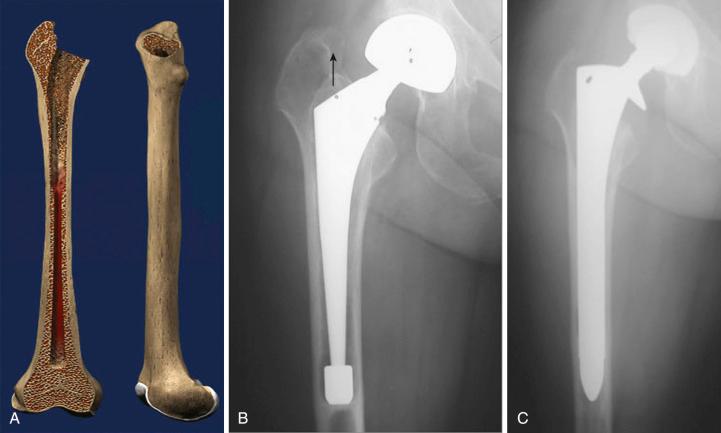
Type II: Extensive loss of metaphyseal bone with an intact diaphysis ( Fig. 100.2 ).
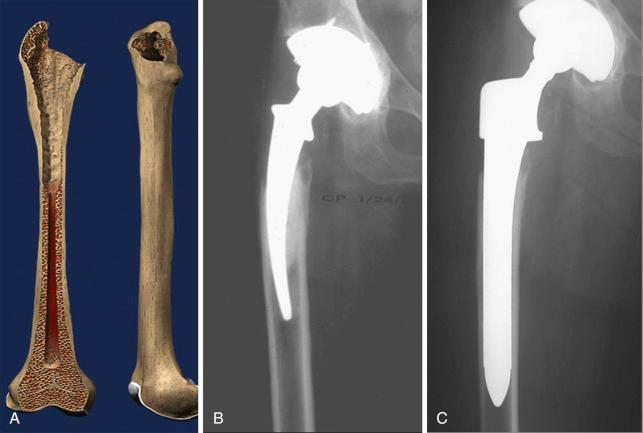
Type IIIA: The metaphysis is damaged and unsupportive; a minimum of 4 cm of intact cortical bone is present in the diaphysis at the isthmus ( Fig. 100.3 )
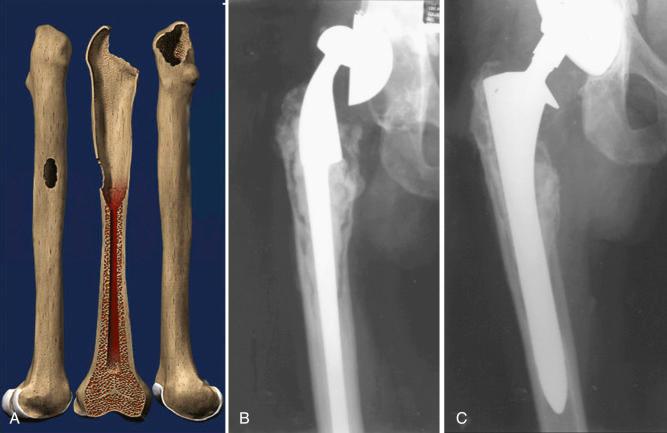
Type IIIB: The metaphysis is damaged and unsupportive; intact cortical bone measuring less than 4 cm is present distal to the isthmus ( Fig. 100.4 )
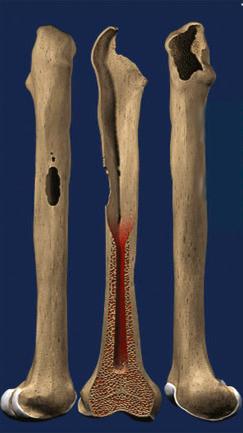
Type 4: Extensive metaphyseal and diaphyseal damage; the femoral canal is widened and is not supportive ( Fig. 100.5 )
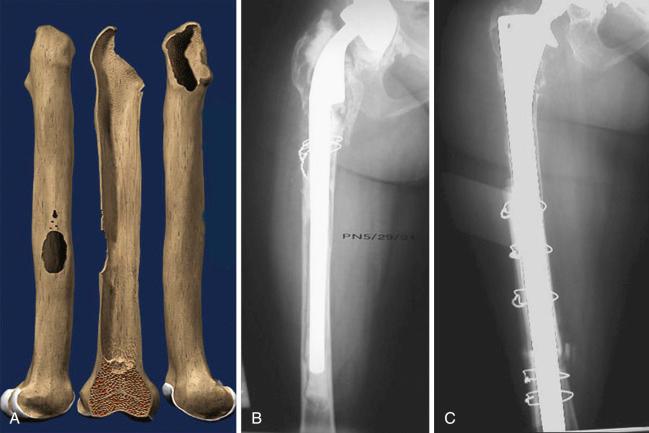
Fully porous-coated stems are indicated for use in the revision femur for Paprosky types I through IIIA femoral defects. Success is dependent on achieving initial implant stability that will allow adequate bony ingrowth to provide long-term fixation. In general, a minimum of 4 to 6 cm of diaphyseal bone should be available to allow for stable fixation. The term scratch fit is used to describe the mechanical fit of the cylindrical stem into the host diaphyseal bone. This scratch fit is dependent on meticulous canal preparation and selection of an appropriately sized implant based on preoperative templating and intraoperative findings.
As with most surgical procedures, revision with a fully porous-coated stem is contraindicated in patients with active and ongoing infection. A thorough history, physical examination, and laboratory testing are required to exclude the possibility of infection before proceeding with revision surgery. In addition, medically infirm patients who are too ill to undergo revision surgery should be medically optimized before surgical intervention is provided.
Because the success of fully porous stems in revision total hip arthroplasty is dependent on achieving intimate fit in the diaphysis over a minimum of 4 cm, these types of stems are contraindicated in patients with severe diaphyseal bone loss. The type IV femur is characterized by significant diaphyseal damage with a capacious medullary canal. In these situations, attaining initial implant stability to achieve bony ingrowth is difficult, if not impossible. The type IV femur is best treated with alternative means of reconstruction, including impaction grafting, allograft prosthetic composite, fluted tapered modular stems, and proximal femoral replacement.
Della Valle and Paprosky reported on the limits of fully porous-coated stems in revision total hip arthroplasty. In this study, hips reconstructed with fully porous-coated stems in types IIIB and IV femurs were evaluated. Patients with fully porous stems greater than 19 mm in diameter with IIIB femoral defects had a mechanical failure rate of 18%. In patients with type IV femoral defects and stems greater than 19 mm, the mechanical failure rate was 37.5%. The authors speculate that these patients with poor bone stock and large canals do not have appropriate bony support to allow for initial axial and rotational stability. In these situations, the authors recommend using alternative techniques for femoral fixation.
Become a Clinical Tree membership for Full access and enjoy Unlimited articles
If you are a member. Log in here